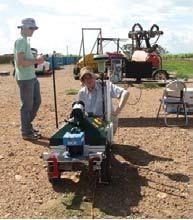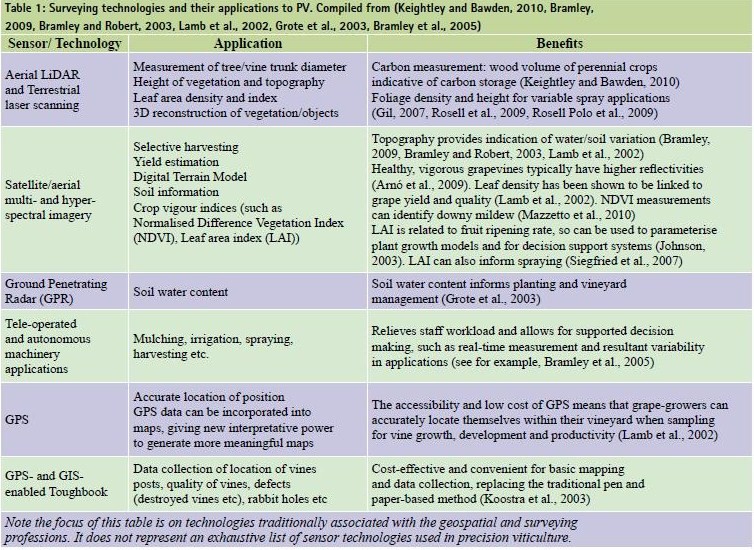| Applications | |
Spatially Smart Wine
..
Precision viticulture (PV) is styled from the zonal management paradigm of precision agriculture, where large homogeneous fields are divided into smaller units based on yield or other field characteristics which may be differentially managed (Lamb et al., 2002, Bramley, 2009, Bramley and Robert, 2003) (Note that McBratney et al. (2005) suggest the definition of precision agriculture is continually evolving as we develop further technologies and greater awareness of agricultural processes). PV acknowledges the numerous spatial variations that affect grape quality and yield, including soil characteristics, pests and diseases and topography (Hall et al., 2003, Arnó et al., 2009), providing land managers with the tools to quantify and manage this variability (Proffitt, 2006). Land managers can thus ‘selectively’ treat areas, for example by the variable application of mulch, water, fertiliser, sprays etc. The general process of PV is cyclical across observation, evaluation and interpretation – which informs a targeted management plan followed by ongoing observation and evaluation (Bramley et al., 2005). The benefits of PV are increased knowledge of vineyard processes, allowing for targeted improvements to yield, wine quality, reduced disease incidence and increased resilience across the vineyard (Johnson et al., 2003). Data capture undertaken as part of PV can inform mechanised operations for greater efficiency in irrigation, spraying, mulching and pruning, and selective harvesting. Decision support systems are further supported and may aid land managers when in the field (Johnson et al., 2003). PV mitigates against the growing problems of climate change (Battaglini et al., 2009, Shanmuganthan et al., 2008), food security (Gebbers and Adamchuk, 2010) and supports the growing awareness of the consumer and market demands (Delmas and Grant, 2008, Rowbottom et al., 2008, Chaoui and Sørensen, 2008). Research into the use of autonomous machinery in vineyards is still young and presents opportunities for further development (Grift et al., 2008, Longo et al., 2010). The use of wireless sensor networks is a recent addition to PV, but not yet routinely implemented (see examples in Shi et al., 2008, Matese et al., 2009, López Riquelme et al., 2009, Morais et al., 2008). A significant limitation of current applications and research is the lack of an appropriate, multi-functional decision support system (McBratney et al., 2005, Arnó et al., 2009). This research focuses on the contribution of surveying and spatial technologies to PV, with a focus on sensor applications for tele-operated and autonomous machinery. This paper reports the preliminary findings of a scoping fieldtrip, with an outline of technologies tested for their utility and suitability to the client’s needs. The ‘Spatially Smart Wine Project’‘Spatially Smart Wine’ is a joint initiative of the International Federation of Surveyors (FIG) Young Surveyors Network, the New South Wales Institution of Surveyors Young Surveyors Group (Australia) and the University of New South Wales Schools of Surveying and Mechatronic Engineering. The project was initiated to improve the networks and skills of young surveyors in the Sydney region, and to generally improve community understanding of surveying (see Figure 1). Additional benefits are increasing surveyors’ knowledge of PV! General details of how the project was run are reported in Fairlie and McAlister (2011). Fieldwork was undertaken at Jarrett’s wines, a small to medium (300 hectare) vineyard 30km south west of Orange, NSW, Australia – approximately 300km west of Sydney. Established just over 15 years ago, the management of the vineyard now incorporates organic and biodynamic farming principles. The vineyard manager sees PV as a critical element of sustainable vineyard management. Biodynamic viticulture rejects the use of synthetic chemical fertilisers and pesticides. Both organic and biodynamic farming practices embrace the use of natural products, but the underlying philosophy of biodynamics is the use of soil and plant ‘preparations’ to stimulate the soil and enhance plant health and product quality (Reeve et al., 2005). The adoption of organic and/ or biodynamic farming practices is likely to increase with greater awareness of climate change and sustainability requirements (Turinek et al., 2009). The general thesis of these farming processes is sustainable agriculture, with no long term environmental damage. There remain a number of research gaps in organic and biodynamic farming practices – for example, critics cite a lack of scientific understanding and rigour within the biodynamic field (Kirchmann, 1994) . PV technology has a role to assist, for example in research on soil nutrient variability, mapping and management, weed control, and achieving dual outcomes of economic and environmental sustainability. Research is advancing with regards to robotic weeders, online systems to manage soil nutrients and crops, but commercial adoption and availability of products is limited (see Dedousis et al., 2010 for an overview of the field). The general goal of the fieldwork was the testing of survey and spatial technologies for PV, particularly taking into account client needs and fitness-for-purpose. Figure 1: The authors at Jarrett’s Vineyard Outline of this paperIn the following sections we will provide an overview of surveying technologies applicable to PV, an initial high level qualitative analysis of technologies tested, and finally an overview of the outputs and accuracies achieved in uniting the Unmanned Ground Vehicle with surveying technologies. Application of surveying technologies to precision viticulturePV requires much finer sampling than precision agriculture (Bramley and Janik, 2005), hence the greater need for surveying and spatial professionals to engage with this industry. Viticulture is particularly suited to spatial and surveying technologies, due to the ‘fixed’ nature of plantings and the perennial nature of crops (Arnó et al., 2009) and spatial analysis is critical to managing vineyard productivity and minimising risk in small scale vineyards. Vineyard establishment in Australia will typically involve soil sampling (including type mapping, salinity measurements and moisture distribution), topographic mapping and surveyor set-out of plantings, with grape varieties located according to appropriate soil type, nutrient and moisture levels. Topographic variation is a critical driver of vineyard yield variation (see Bramley 2006, Bramley and Williams 2007), particularly in the Australian case where yield is closely linked to water supply and generally varies with topography (Bramley 2003b). Once established there are a number of ongoing roles for spatial data and analysis. Vineyard leaf area is a key determinant of grape characteristics and wine quality and is a predictor of fruit ripening rate and instances of infestation and disease. Vineyard leaf area measurements can inform pruning procedures, shoot thinning, leaf removal and irrigation (Johnson et al., 2003). International monitoring of emissions for climate change mitigation and adaptation is further creating a role for spatial technology in the vineyard. Transient biomass (changes in biomass from year to year) provides an indication of the most productive areas of the vineyard, and monitoring of biomass may be a future requirement of climate change policy. Measurement of transient biomass year by year (i.e. following pruning) is common, but difficult and expensive – remote imaging options present much more efficient forms of measurement (Keightley and Bawden, 2010). Uniquely, Mazzetto (2010) present a ground-based mobile remote sensing lab to allow more frequent and targeted vineyard spatial analysis. Table 1 provides an overview of sensor technologies for PV and their applications and benefits. The paper was presented at FIG Working Week 2011, Marrakech, Morocco, 18-22 May 2011 …to be continued
|























 (56 votes, average: 1.18 out of 5)
(56 votes, average: 1.18 out of 5)



Leave your response!